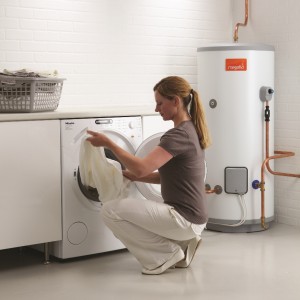Cylinder selection: what your customers need to know
When asked for advice about direct unvented hot water cylinders, it’s important for wholesalers to recommend well-made, high-quality, efficient, high-performance products. Alan Clarke, Technical Support Manager at Heatrae Sadia, explains more.
Increased consumer demand for powerful showers and fast-filling baths means there is now an array of unvented hot water cylinders on the market – meaning electrical wholesalers are more likely to be asked for advice on the many options available.
When making recommendations, the key things to consider are materials, performance, energy efficiency and warranties.
As unvented cylinders store water under pressure, it is essential that they are strong, durable and corrosion resistant. In the UK, cylinders are generally made from stainless steel, copper or glass lined mild steel. Cylinders made from mild steel will, however, require a coating or glass lining to make them corrosion resistant. They also need a sacrificial anode, as do some cylinders made from low-grade stainless steel. The anode will need to be monitored for signs of erosion each year.
Duplex stainless steel is by far the preferred material in the manufacture of unvented cylinders, as a result of its outstanding and unique corrosion resistant properties. It is also lightweight, giving it a strength-to-weight ratio advantage.
Heatrae Sadia pioneered the use of Duplex stainless steel, and for longer cylinder life we use a combination of laser and TIG welding, and butt joints to avoid crevices, and also carry out comprehensive, state-of-the-art post weld treatments.
It’s not just the material that the internal cylinder is made from that’s important either; on a direct cylinder, the immersion heater is used frequently, and therefore needs to be made from a high-grade material. Titanium is a good indicator of quality.
Quality and performance
Consider the manufacturing processes too. Hot water cylinders that are properly manufactured, built to last and operate safely will have been constructed and tested to established British and European standards, and manufactured in a factory which has accredited Quality Management Systems. Third party approvals – such as from WRAS and KIWA – also demonstrate quality and performance.
Market leading brands will also invest in the performance of their products, whether that’s by improving flow rates, recovery times, the amount of stored hot water available or standing heat losses – and this can all be researched via manufacturers’ literature.
We insulate our T&P valves to reduce heat loss, and we use an L-shaped heating element rather than a straight one to ensure the whole cylinder is heated, and a patented inlet diffuser that ensures excellent stratification and hot water output.
It is also essential to review a product’s energy efficiency, which has become easier thanks to the energy labels that should now be supplied with water heaters with outputs of up to 70kW and hot water storage tanks with storage volumes of up to 500 litres – all part of the ErP Directive.
The energy efficiency bands on the labels currently range from A to G, but will eventually extend to A+++, and band G will be removed in 2017. As well as stating the energy efficiency band, directly heated water heaters also include a size (load) profile, ranging from 3XS to 4XL.
ErP Directive
As well as providing a label, manufacturers of all water heaters and hot water storage tanks in the scope of the ErP Directive should also provide additional performance and efficiency parameters via a ‘technical fiche’ and within product data, which must be included on websites and in installation instructions.
It is important for wholesalers to advise installers to also refer to technical fiches and other product literature, especially when water heating products in the same band are being compared against one another.
End users will expect their new hot water cylinder to have a long and reliable life, and comprehensive warranties will offer peace of mind that should anything go wrong, they will be covered. Particular things to consider are whether onsite parts and labour costs are included, whether the warranty is transferrable to new owners if the property is sold, and what the level of support offered is like – e.g. it’s worth looking at the size of the call centre, the opening hours and the level of engineer coverage across the UK.
All unvented cylinders might initially seem the same, but there will be important differences between brands. In the long run, recommending products that offer the best possible quality, performance, innovation, efficiency and warranties will result in a higher level of customer satisfaction and reduced call backs for installers.




